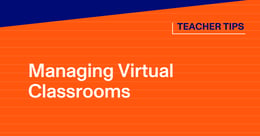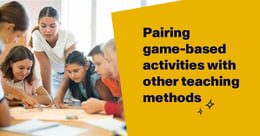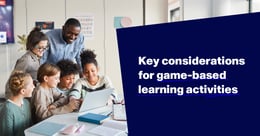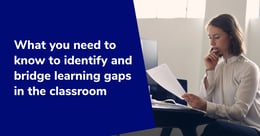
7 accelerated learning techniques: Tips for teachers
To meet the challenges of an unprecedented learning landscape, many teachers are incorporating a wider variety of instructional strategies into their everyday classroom routines.
Specifically, as districts across the country promote learning acceleration to ensure students stay on target in the face of widespread academic disruption, educators are interested in learning which accelerated learning strategies are the most effective.
To accelerate learning, students are taught standard grade-level content while receiving just-in-time support to address potential learning gaps. In turn, teachers are looking for proven accelerated learning techniques so they can help students reengage with school and continue to grow.
In-depth accelerated learning techniques for teachers
Given this understanding of learning acceleration, what are some concrete steps teachers can take to build students’ comprehension of key concepts? And what are some specific strategies educators can deploy to support the overarching goals associated with accelerated learning?
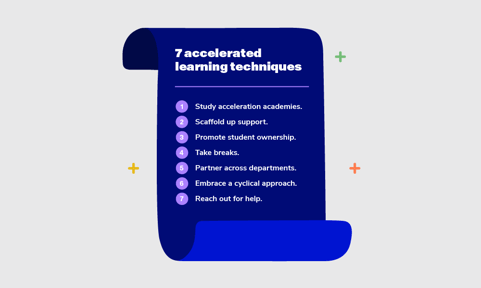
Here, we’ll explore several elements of learning acceleration and discuss how they connect to classroom instruction.
1. Follow best practices exemplified by acceleration academies
There are various methods districts may employ when building out accelerated learning programs. One popular option is to implement acceleration academies as a complement to in-class instruction.
In Massachusetts, for example, a case study about the Lawrence Acceleration Academies—an education program that launched years prior to the onset of the COVID-19 pandemic—explored how students in the district benefited from intensive small-group support that took place during spring break weeks.
The report’s authors explained that such a strategy can help form an important component of a “virtuous cycle of innovation” in educational spaces.
To teach in an acceleration academy, educators often need to undergo additional preparation and training. Keep reading for some general notes about instructional best practices in literacy and math from the Massachusetts Department of Elementary and Secondary Education.
Best practices from acceleration academies: Literacy
An acceleration academy guidebook [download] from the state’s education agency recommended that literacy teachers start the morning with work on foundational skills—including phonological awareness, fluency, and phonics and decoding—before engaging with complex texts.
Importantly, the authors note that texts should be “authentic and meaningful,” with learning time consisting of out-loud or independent reading, classroom discussion, and the opportunity to formulate responses to the reading. Ongoing assessment can help guide instructional approaches, and data should inform how teachers prioritize practice in foundational skills to support students.
Best practices from acceleration academies: Math
A similar guide for math acceleration academies [download] suggests that teachers split their focus among three crucial pillars: conceptual understanding, application, and procedural fluency. Ideally, lessons should start with a practical scenario in which students can explore how the day’s targeted skills connect to realistic situations and the students’ prior knowledge. Such sessions can also double as assessment opportunities, helping educators discern how to best tailor their approach to the material.
Keep in mind that unfinished learning impacts more than math and literacy. Although some acceleration academies focus exclusively on these specific subjects, learning acceleration techniques can be used in science, social studies, and other areas to help students access new information while addressing learning gaps as needed.
2. Implement scaffolded support
There are many different kinds of scaffolded supports that teachers can use to help students close learning gaps as they acquire new skills. Here are a couple of examples of potential supports:
Text sets
Noting that thoughtful implementation of learning acceleration programs is essential for success at the local level, the California Collaborative for Educational Excellence (CCEE) has compiled several relevant teaching tips. Among these suggestions, the group encourages the use of text sets: Assortments of background materials created by teachers—often incorporating a variety of different media—to help students explore otherwise unfamiliar topics.
The Frayer Model
One widely used scaffold—which can assist students across grade levels in math, literacy, and other subjects—is the Frayer Model. A Texas Computer Education Association blog post on the Frayer Model explored various iterations of this popular four-square graphic organizer, which is commonly used to complete vocabulary-building exercises. Students can use this method to gain a deeper understanding of key concepts that are crucial for meeting grade-level standards. In the process, they can explore definitions, antonyms, and multimedia examples of the key term they’re studying.
For more in-depth examples of ELA and math scaffolds, including descriptions of how to use such supports for a wide range of grade levels, check out the New York State Education Department’s scaffolding resource guides.
3. Promote student ownership throughout the learning process
Even in the best of times, student motivation can occasionally use a boost. Given the rigorous demands of learning acceleration, it’s more vital than ever that students are deeply engaged in the learning process and empowered to own their education.
The National Institute for Excellence in Teaching believes that “increasing student ownership positively contributes to learning acceleration.” To elaborate on this concept, the organization describes several activities that reflect student ownership, including proactive goal-setting, developing connections between schoolwork and lived experiences, and discerning which learning activities contributed most strongly to understanding course content.
In conjunction with facilitating student ownership, it may be helpful for learners to develop their metacognitive skills—in other words, awareness of how they think and learn.
In an Edutopia article about how to teach students to assess their own learning, Nina Parrish recommends several different techniques, such as:
- Strategy notebooks: Students can document how they feel about using different learning strategies.
- Student-led conferences: Learners showcase portfolios of their work, exploring with caregivers how their understanding has evolved throughout a unit.
4. Keep taking breaks
Remember: Learning acceleration strategies emphasize depth—not speed. Instead of getting wrapped up in worries about how to learn faster, remember to take a step back every once in a while. Nobody can work constantly for an unlimited amount of time, and that includes teachers and students.
Citing a study in which researchers showed how patterns in neural activity were impacted as participants practiced a new skill, a recent Edutopia article asserted that brain breaks are important for learning. Frequent and brief departures from time spent in active learning to stretch, move around the room, or just let the mind rest could go a long way in the classroom.
However, don’t lose sight of the fact that all students are different, and no two brains work exactly the same way. It’s best to remain flexible and not overgeneralize new findings, even those contained in evidence-based research. Instead, pay close attention to the diversity of abilities and contexts present in the classroom.
5. Collaborate across departments to offer immersive experiences
Some of the best accelerated learning techniques make learning come alive through active student participation and by applying new skills and understanding to a variety of relevant contexts. Teachers who plan with their peers across departments can use project-based learning experiences to help students develop meaningful connections to their subject matter.
This kind of approach can take different forms. For example, in a discussion about how to drive student engagement, district administrators highlighted interdisciplinary opportunities like STEM programs and entrepreneurship projects.
6. Stay focused on the cyclical nature of learning acceleration
Effective accelerated learning initiatives have a cyclical component. This multistep process, known as a learning acceleration cycle, does not conclude at the end of a unit. Rather, student success is contingent on an ongoing practice of assessment, prioritization, fluid support in small groups, and regular readjustment of instructional techniques. As teachers continue to learn more about what works for the students in their classrooms, they’ll further refine their approaches while remaining open to new ideas from one unit to the next.
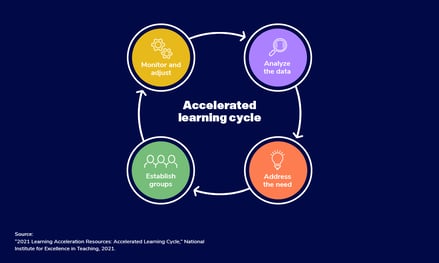
7. Don’t do it alone
In addition to paying attention to federal, state, and local guidelines on how to implement accelerated learning techniques in the classroom, professional development opportunities can help educators and local leaders keep their skills sharp.
Look out for relevant teacher training opportunities locally and online. For example, free CCEE courses are available on demand, including several modules focused on accelerated learning topics. In particular, members of instructional leadership teams may be interested in joining a class on how to develop and implement learning acceleration plans. Courses are offered in partnership with the University of California, San Diego.
Within the school building, teachers can also assist each other by making it easier for educators and students alike to access the existing support systems. For instance, Dr. Stephanie Rosch wrote about how she helped peers implement Paper tutoring in the classroom.
“Our planning team’s goal was to do as much of the prep work for our colleagues as we could,” said Rosch. “That way, they wouldn’t think of Paper as yet another addition to their already full plates.”
[READ: “5 ways tutors can act as assistant coaches for teachers (Infographic)”]
Learning acceleration techniques: Several tools, one solution
Accelerated learning is a complex, multifaceted process. There’s no single solution, tactic, or technique that teachers can employ to make sure they’re helping their students address the challenges posed by unfinished learning while also supporting their continued growth. But with teamwork, careful planning, and a good dose of flexibility, educators can boost student confidence and support their learners in reaching new heights.
Ready to learn more about how to help students thrive in today’s challenging climate? Take a look at our K-12 guide to learning acceleration.

